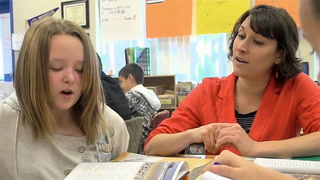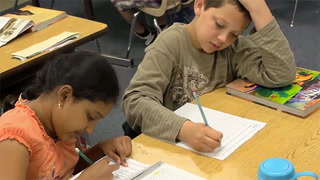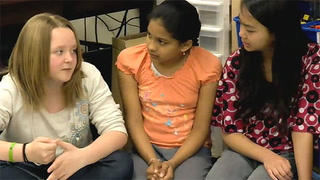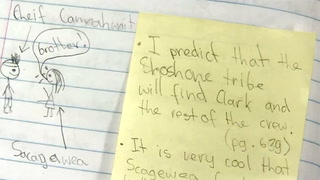Series Analyzing Texts: Analyzing Texts: Overview of a Lesson Series
ELA.SL.5.1
| Common core State Standards
- ELA: English Language Arts
- SL: Speaking and Listening
- 5: 5th Grade
-
1: Engage effectively in a range of collaborative
discussions (one-on-one, in groups, and teacherled)
with diverse partners on grade 5 topics and
texts, building on others'\x80\x99 ideas and expressing
their own clearly.
a. Come to discussions prepared, having read
or studied required material; explicitly draw
on that preparation and other information
known about the topic to explore ideas under
discussion.
b. Follow agreed-upon rules for discussions and
carry out assigned roles.
c. Pose and respond to specific questions by
making comments that contribute to the
discussion and elaborate on the remarks of
others.
d. Review the key ideas expressed and draw
conclusions in light of information and
knowledge gained from the discussions.
ELA.RI.5.1
| Common core State Standards
- ELA: English Language Arts
- RI: Reading Standards for Informational Text K-\x80\x935
- 5: 5th Grade
-
1:
Quote accurately from a text when explaining
what the text says explicitly and when drawing
inferences from the text.
ELA.W.5.2b
Common core State Standards
- ELA: English Language Arts
- W: Writing Standards K-5
- 5: 5th Grade
-
2b:
Write informative/explanatory texts to examine a
topic and convey ideas and information clearly.
a. Introduce a topic clearly, provide a general
observation and focus, and group related
information logically; include formatting (e.g.,
headings), illustrations, and multimedia when
useful to aiding comprehension.
b. Develop the topic with facts, definitions,
concrete details, quotations, or other
information and examples related to the topic.
c. Link ideas within and across categories of
information using words, phrases, and clauses
(e.g., in contrast, especially).
d. Use precise language and domain-specific
vocabulary to inform about or explain the
topic.
e. Provide a concluding statement or section
related to the information or explanation
presented.
Save to My Resources
PLEASE CREATE A NEW ACCOUNT OR LOG IN TO ACCESS THIS CONTENT
Enjoy your first video for free. Subscribe for unlimited access.
Have questions about subscribing?
Click Here to learn more about individual subscriptions.
Click Here to learn more about School and Institution access.
Discussion and Supporting Materials
Thought starters
- How does Ms. Brewer plan tasks that address Common Core Standards across ELA (Speaking & Listening, Reading, and Writing)?
- What makes these lessons both distinct and connected?
- How does Ms. Brewer think about her particular students when planning these lessons?
School Details
Stevenson Elementary School14220 Northeast 8th Street
Bellevue WA 98007
Population: 684
Data Provided By:

Teachers
Stacy Brewer
Newest
|
4 MIN
|
5 MIN
|
5 MIN
UNCUT CLASSROOMS
| TCHERS' VOICE
English Language Arts












44 Comments
LaBresha Small Mar 11, 2024 10:26pm
Joann Miller Feb 3, 2024 2:43pm
Stacy talks about text that they have read. She has small group time to brain storming ideas. They have text talk time where they are able to discuss the authors viewpoint. It enables them to draw evidences to support their thinking.
Kassandra Amaya Oct 14, 2023 12:31am
A) She plans her lesson in which before writing down for an assignment, she first gets her students to have an open discussion with each other in multiple groups. They get to bounce of their thoughts on the text before writng down anything concrete.
B) For most of these lessons, the main goals for these discussions would be to get the students to share their viewpoints on the text and to have all their thoughts and opinions out in the open before they start their writing. Its also gives them an opportunity to practice their coversation skills. Other goals would be to get her students to draw evidence from the text to support thinking, being able to quote directly from the text, coming prepared for a collaborative discussions
C) When in the group with the ELLs, she knew that she needs to give them more opportunitys to talk in the group so that can build up their speaking skills. She makes sure that everyon in the groups gets an opportunity to speak.
Tiffany Baltazar Oct 2, 2022 6:45pm
1. Ms. Brewer plan tasks that address Common Core Standards across ELA (Speaking & Listening, Reading, and Writing) by engaging the students to collaborating in small group first before whole class.
2. What makes these lessons both distinct and connected are the students are really engage in " text talk time".
3.Ms. Brewer think about her particular students when planning these lessons that majority of her students speaks a different language at home.
Kelsey Pratt Nov 12, 2020 12:23pm
1.) To begin with, Ms. Brewer addresses the Common Core task of engaging effectively in a range of collaborative discussions through incorporating 'Text Talk Time' in her classroom. At this point, all of the students are able to participate in a group-wide discussion by sitting in an open circle on the floor and viewing eachother. In this open setting, the fifth grade students were able to practice the task of quoting accurately from the Lewis and Clark text and drawing inferences. For example, Ms. Brewer hit another common core standard when she asked them to consider the viewpoint of the author towards Lewis and Clark as historical figures. She also asked that they provide textual evidence to support their argument, which is a key skill for young students to develop as they prepare to enter middle school. Finally, students were able to practice their speaking and listening skills through actively hearing what their classmates had to say about the Lewis and Clark text and adjusting their own opinions based off of their peers.
2.) To make the class engaging for the students, Ms. Brewer breaks the lesson down into three different yet interconnected sections. At the beginning, the fifth graders work in groups to discuss evidence that supports their opinion on the author's viewpoint towards Lewis and Clark. Then, the students take that textual evidence with them as they transition to 'text talk time.' In partiuclar, one student was able to share why she thought that the author viewed the pair as heroic when he described the celebration that Lewis and Clark received upon returning home from their expedition. Finally, Ms. Brewer provided a sentence starter that allowed for her students to answer the main question in writing: "What is the viewpoint of the authors, and why? What textual evidence can you use to support your thoughts?" While sixteen students worked independently to begin writing an answer to this question, Ms. Brewer worked individually with a group of her eight ELL students. This was helpful, as she was able to ensure that they truly understood the meaning of the word "viewpoint" and its relation to the central question that she was asking. Although different parts of the larger lesson required students to critically read, write, and then speak and listen as a class-wide group, all of the skills that the students enacted helped them to develop their understanding of 'viewpoint' in historical texts.
3.) To begin with, Ms. Brewer addresses the needs of all of her students through incorporating 'text talk time.' As the students began to make textual inferences, they needed a group-wide outlet to discsuss their ideas about the authors' viewpoint towards Lewis and Clark. Overall, Ms. Brewer created a helpful space where students' ideas were either supported or challenged in a healthy manner. Most importantly, Ms. Brewer incorporated a scaffolding activity for a group of her ELL students. She was careful to note that without an accurate understanding of the word 'viewpoint,' the students may be overwhelmed when approaching the central question that asked them to idenitfy the perspective of the author. Through conducting a small group with the ELL's, she provided them with a critical opportunity to verbally formulate a working definition for the word 'viewpoint.' Only when the students understood the word 'viewpoint' to mean 'the way that you see/think about a certain situation' did Ms. Brewer ask them to begin identifying textual evidence that supported their claims.